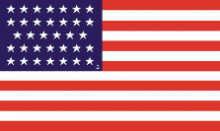|
American Flag |
The Story Behind the Term "Old Glory" This famous name was coined by Captain William Driver, a shipmaster of Salem, Massachusetts. His mother and her circle of sewers presented him with a beautiful twenty four star flag in 1824. Twice it went around the world. In 1831, leaving on one of his many voyages aboard the brig Charles Doggett, as the banner opened to the ocean breeze for the first time, he exclaimed "Old Glory!". This voyage would climax with the finding of the mutineers of the H.M.S. Bounty on Pitcairn's Island. Captain Driver retired to Nashville, Tennessee in 1837, taking his treasured flag from his sea days with him. In 1860, the Captain's wife and daughter took the flag apart, cut off the raveled and frayed seams, replaced the old stars and added new ones to make 34 total (the correct number for the date) and embroidered an anchor in the lower right corner of the canton, to commemorate Captain Driver's sea service. By the time the Civil War erupted, most everyone in and around Nashville recognized Captain Driver's "Old Glory." When Tennessee seceded from the Union, Rebels were determined to destroy his flag, but repeated searches revealed no trace of the hated banner. Then on February 25, 1862, Union forces captured Nashville. The Captain was on hand to greet the Sixth Ohio Regiment when they became the first to enter the city; they followed the Captain home, where he began ripping at the seams of his bed cover. As the stitches holding the quilt-top to the batting unraveled, the onlookers peered inside and saw "Old Glory"! Captain Driver gently gathered up the flag and returned with the soldiers to the capitol. Though he was sixty years old, the Captain climbed up to the tower to hoist his beloved flag. The Sixth Ohio Regiment cheered and saluted – and later adopted the nickname "Old Glory" as their own, telling and re-telling the story of Captain Driver's devotion to the flag which is honored yet today. In 1873, the Captain gave the flag to his daughter, Mrs. Mary Jane Roland, who in turn gave it to President Warren G. Harding in 1922. The President deposited it with the Smithsonian Institution, where it remains to this day. Captain Driver's grave is located in the old Nashville City Cemetery, and is one of the places authorized by act of Congress where the Flag of the United States may be flown 24 hours a day. |

